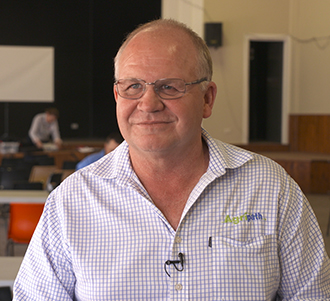Could benchmarking help growers survive the next dry?
Could benchmarking help growers survive the next dry?
Author: Toni Somes | Date: 14 Jan 2020

Finances rather than philosophy is agricultural benchmarking expert Simon Fritsch’s speciality, but you could be mistaken for thinking otherwise when he describes the impact of the ongoing drought on farm bank accounts: “While we all lose in a drought, some lose less”.
The Tamworth-based farm business consultant was a key speaker at the Grains Research and Development Corporation’s (GRDC) Dealing with the Dry forums held in New South Wales and southern Queensland in recent months.
The forums were initiated to bring specialist advice direct to drought affected communities on topics such as agronomy, farm business, government support and debt management.
GRDC Grower Relations Manager – North, Susan McDonnell, said the forums, captured in a new GRDC video series https://youtu.be/2LzGHe0rRj4 were about delivering practical information and support to grain growers in drought affected regions during some of the toughest seasons on record.
“It was invaluable to have someone with Simon’s expertise share his insights into how and why growers in different farming enterprises are faring better through this drought,” Mrs McDonnell said.
“Understanding how aspects of your business, like expenses, compare with similar sized agricultural enterprises is important and can help identify how and where you might be able to reduce costs.
“How people structure their farming enterprises is very individual, but benchmarking really is an opportunity to learn and compare your business with other similar operations in a constructive way.”
She said Mr Fritsch’s presentation had been captured in a short video https://youtu.be/lGpt9TVBD7g to ensure those growers who were unable to attend the GRDC Dealing with the Dry forums could potentially benefit from the information.
“Having a low-cost business is important and that is even more so in a drought,” Mr Fritsch said.
“Benchmarking is one way to identify where your business sits in terms of expenses and income. There can be large differences between the top performers and others similar size businesses.
“The reality is while we all lose in a drought, some lose less.”
In example, Mr Fritsch said some top performing growers in drought areas had an annual losses of -1% return on assets managed (ROAM) in 2018/19, while others in the same region experienced losses of -7% ROAM.
“On a $10 million asset, that’s a $600,000 difference a year. If that rate of loss continues for three to four years, it becomes a very significant difference in wealth erosion between those managing their costs well and those who are not.”
He said regaining control of business expenditure – at any time, regardless of the season – hinged on understanding your production costs and having a clear, business plan.
“Having a farm business plan shows very clearly that you are in the driver’s seat. You cannot control everything, but a logical plan articulates to your financier, and the people around you, that you have thought through the issues and are making informed decisions,” Mr Fritsch said.
“This plan is critical when it comes to things like employees and can help with decision-making on things such as, accrued leave or whether you can afford to tackle low cost, on-farm jobs.
“It is important to have a plan around your staff. What projects can you do that might not cost a lot but might prepare the business to take advantage of the next opportunity when the season breaks?”
Mr Fritsch said the grain industry’s top performers were also able to take a strategic view of their business.
“This may mean ascertaining that you live in an environment where it doesn’t rain at least one in every five years. What you do with that information makes the big difference,” he said.
“For example, at Bellata (in northern NSW) the soil may hold 200mm of plant available water and it’s a 500mm rainfall zone. At 25 per cent rainfall it will take more than 18 months to fill a profile. You can use that information to build a resilient business and a farming system that can capture the upside, but also take away some of the downside.
“That could mean introducing a long fallow in response to lower-than-average rainfall so that moisture in the profile is stored.”
When it came to developing and enacting a farm business plan, Mr Fritsch said it was critical to surround yourself with experienced specialists to support your decision-making.
“Have a good team of people around you, including your banker, accountant and agronomist or farm consultant and make sure your plan is viable and sensible and that you are held accountable to it,” he said.
The GRDC has a dedicated web page https://bit.ly/34FyU7p to provide access to the latest research data and practical agronomic advice to assist with on-farm decision making during tough times.
The Dealing with the Dry page provides easy access to information on the economic, agronomic, farming systems and practical information on nutrient removal, ground cover, weed management and other impacts.
Contact Details
Contact
Toni Somes, GRDC
Toni.somes@grdc.com.au
0436 622 645
GRDC Project Code: SEF1903-001SAX,
